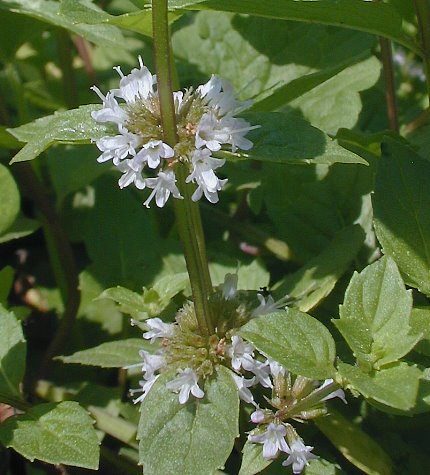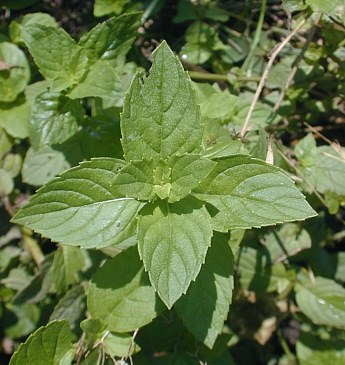
Dense whorls of nearly sessile flowers occur above the middle to upper leaves along a stem; these inflorescences are non-terminal and they do not extend beyond the middle of these leaves. Individual flowers are about 1/8" (3 mm.) in length, consisting of a white to light pink tubular corolla with 4 lobes, a short green or reddish green calyx with 5 narrowly lanceolate teeth, either 4 or no stamens (usually the latter), and either 1 or no pistil with a single style. Some reproductive organs are often missing from the flowers because this hybrid mint is sterile. The calyx of each flower is glabrous, except along the teeth, where it is sometimes ciliate. The very short pedicels of the flowers are glabrous. The blooming period occurs from mid-summer into the early fall for about 1-2 months. Above the whorled flowers of plants in bloom, there are often pairs of opposite leaves that are without developed flowers. Because the flowers are sterile,
Cultivation: The preference is full or partial sun, moist conditions, and fertile loamy soil. This wildflower is easy to cultivate, but it can spread aggressively by means of its rhizomes.
Range & Habitat: The introduced Red Mint occurs across scattered counties in primarily central and northern Illinois; it is uncommon as a naturalized plant within the state. Red Mint was introduced from Europe as a culinary and medicinal herb; it is also somewhat ornamental in appearance. Habitats consist of grassy or sedgy sloughs, low areas along rivers, damp weedy meadows, roadside ditches, edges of yards, and vacant lots. Areas with a history of disturbance are preferred. This mint is sometimes cultivated in gardens under various names.
Faunal Associations: Like other mints (Mentha spp.), the flowers of Red Mint attract small bees, wasps, flies, small butterflies, and skippers; these insect suck nectar primarily. Other insects feed on the foliage and other parts of mints. These insect feeders include the caterpillars of such moths as Agriopodes teratophora (The Gray Marvel), Haploa lecontei (LeConte's Haploa), Pyrausta acrionalis (Mint-Loving Pyrausta), and Sphinx eremitus (Hermit Sphinx); the leaf beetles Kuschelina gibbitarsa and Longitarsus ferrugineus (Clark et al., 2004); the stink bugs Cosmopepla lintneriana and Coenus delius; larvae of the gall fly Giardomyia piperitae; and Chortophaga viridifasciata (Northern Green-Striped Grasshopper). Vertebrate animals dislike the strong-scented foliage of mints and usually avoid them as food plants, although the Ruffed Grouse has been known to feed on their foliage (Bennetts, 1900).
Photographic Location: A weedy slough that was too wet to be mowed during most of the year. At this slough, a sizable colony of plants was found near Champaign, Illinois.

Comments: Another common name of Mentha × gentilis is Little-Leaved Mint. In addition to the usual Mentha spp. (mints), several hybrid mints have been described by various authorities. As a group, these hybrid mints are very difficult to identify and their taxonomy is problematic, notwithstanding numerous revisions through the years. Like some other hybrid mints, Red Mint is a presumed hybrid of Mentha arvensis (Field Mint) and Mentha spicata (Spearmint). Of these two parents, Red Mint has more characteristics in common with Spearmint than Field Mint (e.g., hairless foliage). However, Red Mint could be a more complex hybrid involving a third Mentha sp. (unidentified mint) as a parent. These days, the majority of taxonomists have grouped together formerly distinct hybrids into a single variable hybrid, Mentha × gracilis (Ginger Mint). Thus, such mint hybrids as Mentha × cardiaca, Mentha × gentilis, Mentha × rubra, etc. are now considered variants of Mentha × gracilis (Ginger Mint). However, because of significant variations in leaf shape and size, hairiness of stems and leaves, hairiness of calyces, and other characteristics among these mints, this taxonomic approach has not been adopted here.